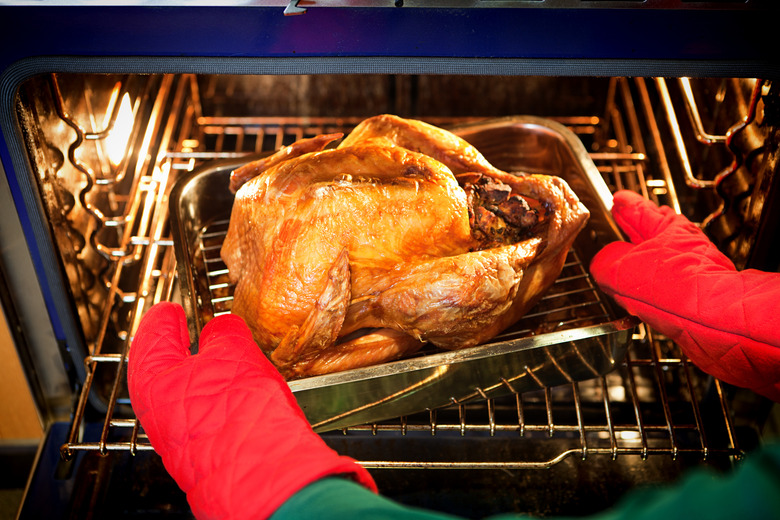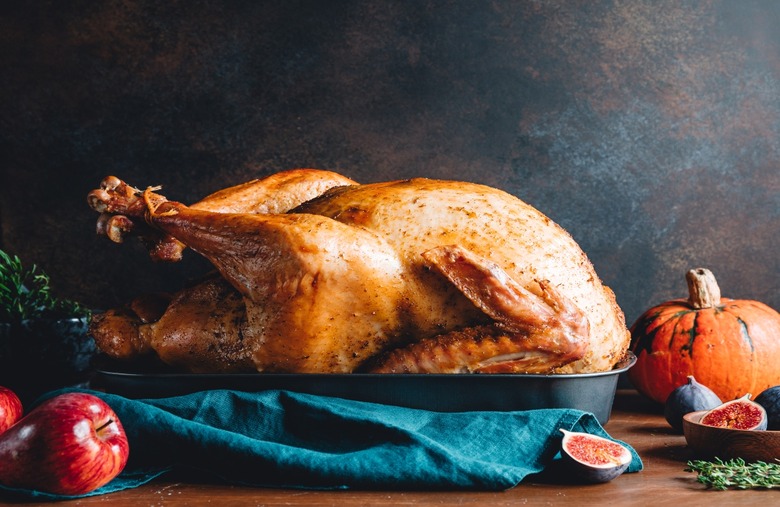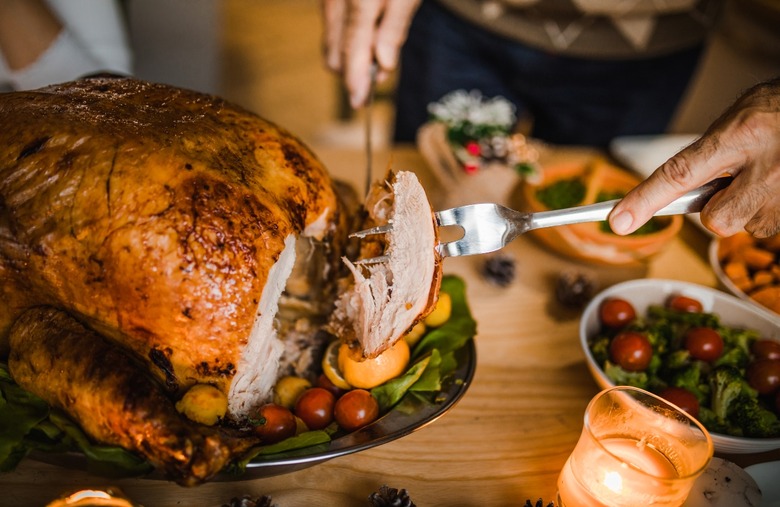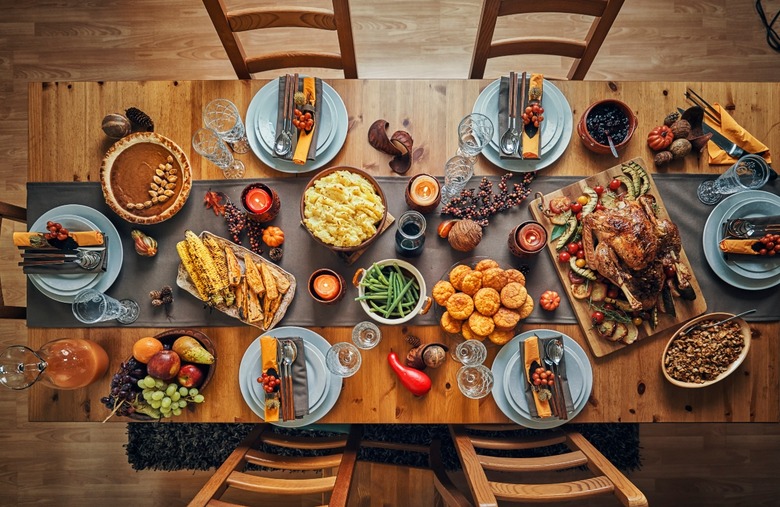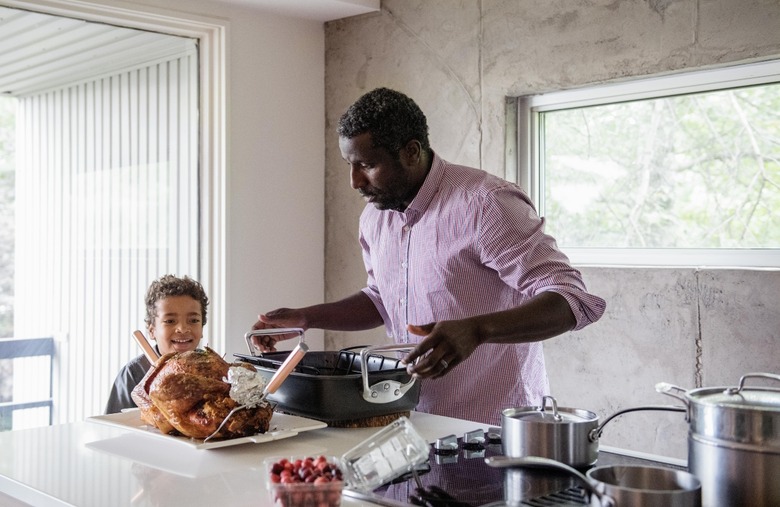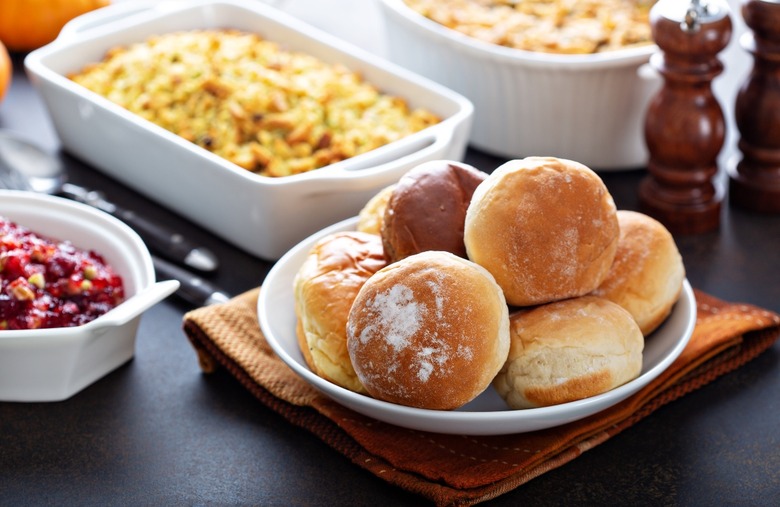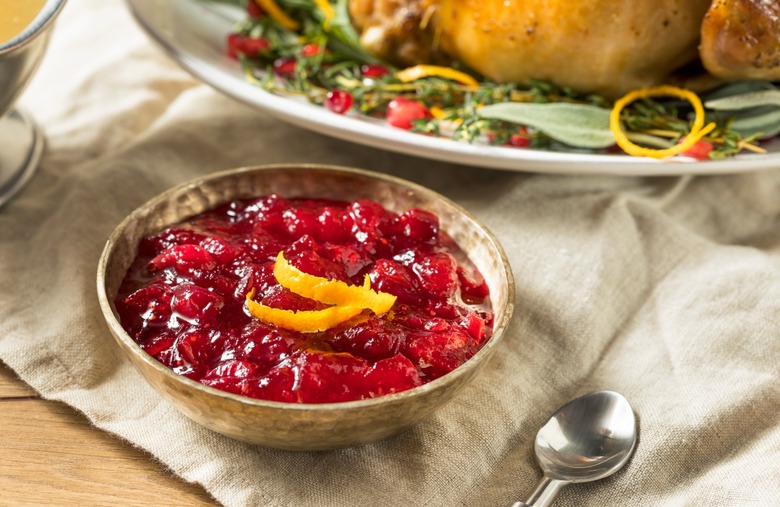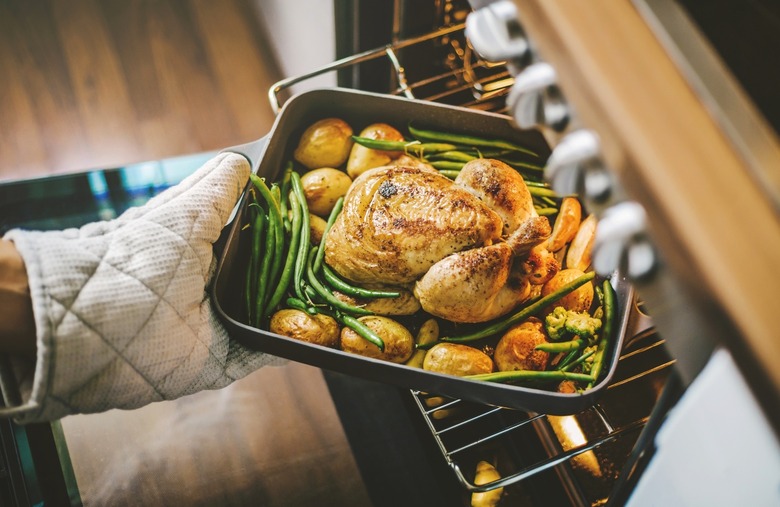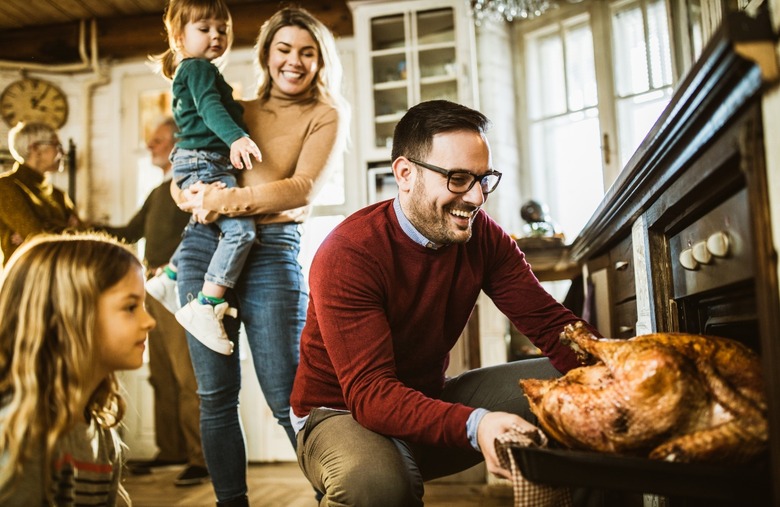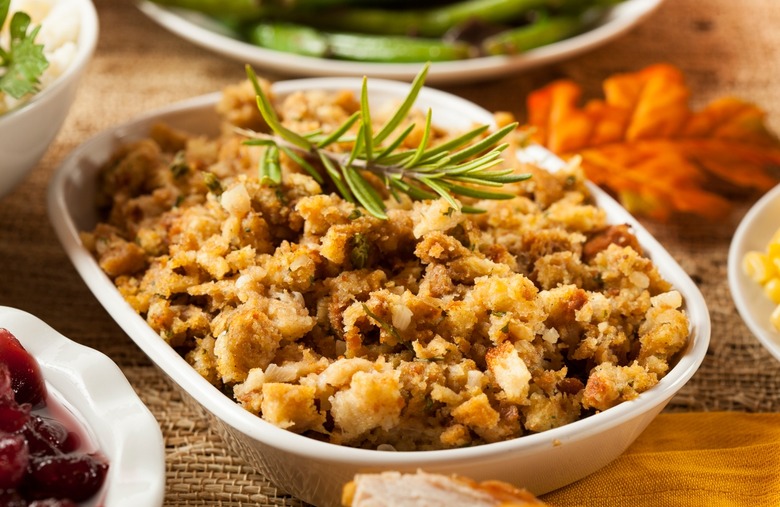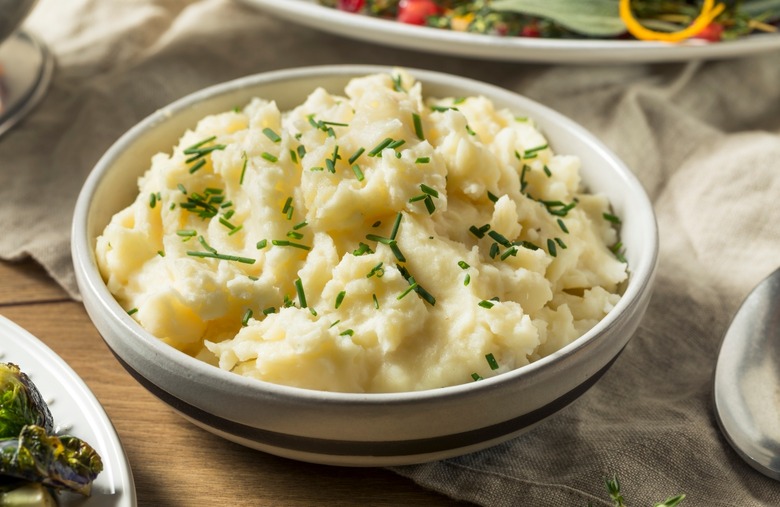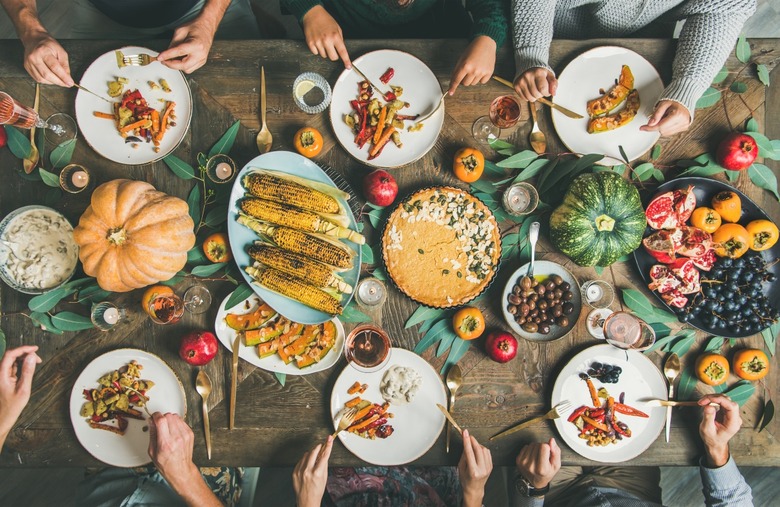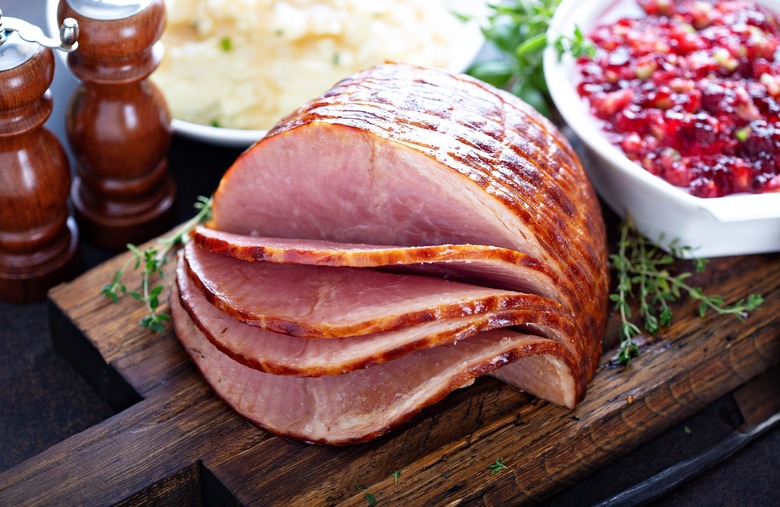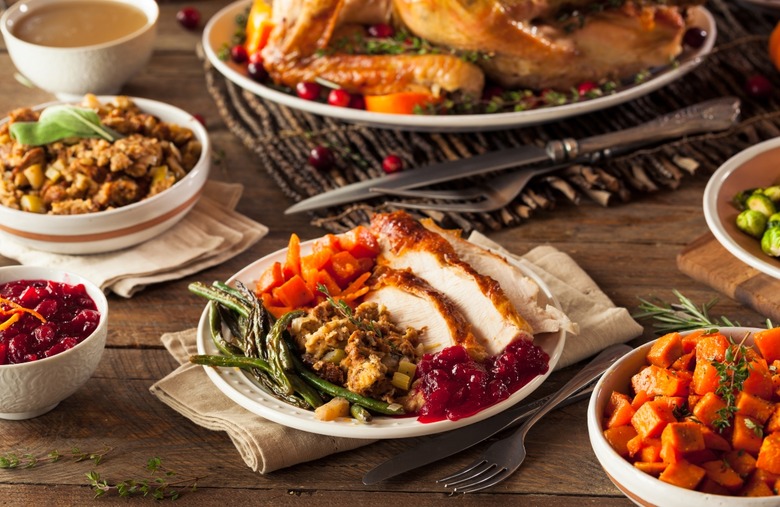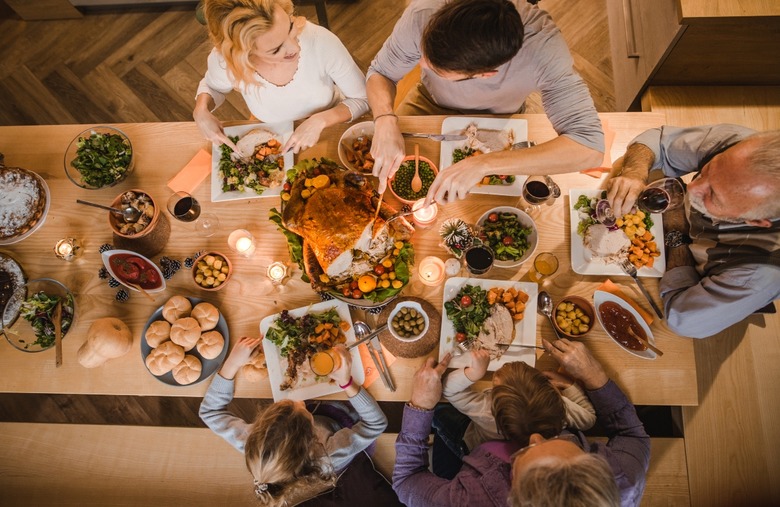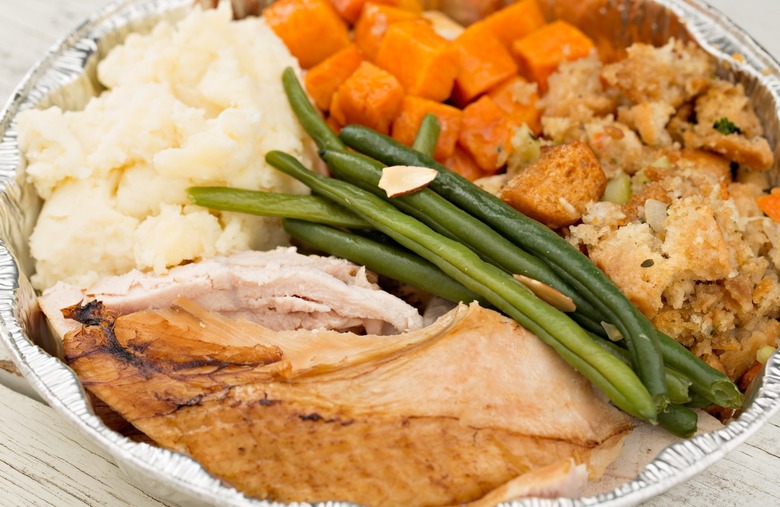How To Thaw A Frozen Turkey? And Other Thanksgiving Questions, Answered
If you're cooking your first Thanksgiving or are just a bit rusty because it's been a year since you last roasted a turkey, it's likely that you have a few questions about how to do this whole "cooking a big, important meal for a crowd" thing. From when you should buy your turkey and how many sides to make to knowing how to fix mushy mashed potatoes, we have the answers to all your most pressing Thanksgiving cooking and hosting questions. We consulted our time at Butterball University and our own experience with cooking Thanksgiving dinners to help you have the smoothest holiday ever.
When do you buy your turkey?
There's no magical timeline for when you should buy your bird, but the earlier you pick up your frozen turkey, the better. Depending on their size, turkeys can take anywhere from two to eight days to defrost in the refrigerator, so you want to be sure to buy them at least that far in advance, if not sooner. How to plan the rest of your Thanksgiving shopping will depend on your schedule throughout the month of November. Buy dry goods (like stuffing mix and flour), canned goods (such as broth or canned green beans) and other non-perishable items whenever you have a chance and spot a good price at your local grocery store. Fresh items, like vegetables and herbs, should be purchased the week of Thanksgiving.
How much turkey do you need to buy?
For a first-time Thanksgiving host, figuring out how much turkey to buy per guest can be overwhelming. But it's actually pretty simple: You're going to want about a pound to a pound and a half per person. While the goal is to stuff your face on Thanksgiving, each individual isn't actually expected to eat 24 ounces of turkey that day. That weight also takes into account the turkey carcass, giblets and an ample amount of leftovers.
How many sides do you need?
There's no right or wrong answer when it comes to how many sides one should make for Thanksgiving. Sides are the best part of the meal, after all. If you're only hosting four guests, it may feel excessive to make mashed potatoes, stuffing, green bean casserole, sweet potato casserole, Brussels sprouts, corn and rolls in addition to your turkey and gravy. Thanksgiving is a holiday that is all about traditions, so prioritize the sides that are the most important to you and your guests and the best-ever Thanksgiving side dish recipes.
What tools do you need to make Thanksgiving dinner?
There are few items you need in your kitchen for Thanksgiving that you may not already have in your arsenal. Notably, you need a roasting pan with a nonstick rack for your turkey. If you don't want to invest in a giant pan just for one day of the year, however, a foil roasting pan can make do. You will also need twine to truss your turkey legs so your bird doesn't dry out. An instant-read probe thermometer is the best way to tell that your turkey is done, so get one of those as well. Other useful tools include a large cutting board, a carving knife, kitchen shears, several casserole dishes, a basting brush and pie plates.
Is it OK to buy some dishes pre-made?
Unless you're Martha Stewart, trying to cook every individual component of your Thanksgiving dinner from scratch is pretty ambitious. Prioritize which dishes are most important to you and your family. If you're nostalgic for your mother's stuffing all year long, make the stuffing from scratch. But some lower-priority dishes, such as an appetizer, garden salad or rolls are among the Thanksgiving dishes you may as well just buy at the store.
Which dishes can you make ahead?
Making some Thanksgiving dishes before the big day itself can help to alleviate a lot of stress from the holiday. A surprising number of favorite foods, including green bean casserole, apple and pumpkin pies, cranberry sauce and rolls are among the Thanksgiving dishes you can make ahead of time.
What’s the easiest homemade side to cook?
If you're not that comfortable in the kitchen, being asked to bring a side to dinner can bring out a lot of anxiety. But there is no need to worry. One classic Thanksgiving side dish, cranberry sauce, is so easy to make from scratch and only requires three ingredients. The night before Thanksgiving, add 1 cup of orange juice and 1 cup of white sugar to a medium-sized saucepan and heat it at a medium temperature until the sugar is completely dissolved in the orange juice. Next, add in one 12-ounce bag of fresh cranberries and cook the berries until they start to pop (about 10-15 minutes), while gently stirring the sauce every few minutes. After that, remove the cranberry sauce from the stove, allow to cool and then place it in the fridge. This dish is simple and budget-friendly but fresh cranberry sauce is sure to impress your friends and family.
How do you defrost turkey?
The safest and easiest way to thaw a frozen turkey is to put it in the refrigerator. However, this defrosting method does require some forethought and several days. To thaw a turkey using this method, take the turkey out of the freezer but keep it in its wrapping. Clear plenty of space on the bottom shelf of your fridge and place a baking tray with raised edges there. Put your wrapped turkey breast-side-up on the tray. Keeping your turkey on the bottom shelf and on a tray will keep the rest of your fridge's contents safe from any rogue drippings that may escape the wrapper. You need to allow one day of thawing time for every four pounds of turkey. For instance, an 18-pound bird will need 4 1/2 days in the fridge.
How long will a thawed turkey be OK in the fridge?
It's good to know how long your food keeps in the fridge. After your turkey is completely thawed, it will keep for three to four days in the fridge. So if your bird is thawed on Monday and Thanksgiving isn't until Thursday, there's no need to freak out. It will be just fine.
If you forgot to thaw the turkey, and it’s the day before Thanksgiving, what do you do?
Not everyone has the foresight to defrost a turkey in the fridge. Luckily, you can do a cold-water thaw for your big bird. All you have to do is place the wrapped turkey in a sink, tub or cooler and submerge it in cold tap water. In order to keep the water from getting too cold at first or so warm so the turkey's no longer safe to consume, swap out the water every 30 minutes. This isn't an instant process, however. For every pound of turkey, you need to defrost it half an hour in the water. So, an 18-pound turkey will need nine hours to defrost.
Should you wash your turkey?
Absolutely not. Washing your chicken or turkey in the sink just splashes raw juices around and will turn your kitchen into a biohazard zone. Instead, just pat your turkey dry inside and out with some paper towels before seasoning.
Is it safe to make stuffing inside your turkey?
It may seem like putting bread and vegetables into the cavity of raw turkey is a recipe for little more than food poisoning, but stuffing your bird can be perfectly food safe. Just be sure to stuff your turkey right before it goes into the oven and roast the turkey and stuffing until the center of the stuffing reaches a temperature of 165 degrees. This, however, can overcook your turkey, so it may be best to cook your stuffing on the side.
What temperature should the oven be at?
For a classic Thanksgiving turkey recipe, your oven should be set to 325 degrees.
How long do you roast a turkey?
The U.S. Department of Health & Human Services has a handy chart outlining how long to roast a turkey at 325 degrees, and it roughly amounts to 25 minutes per pound. For example, a 12-pound turkey will need to roast for 3 hours, while a 20-pound bird should stay in the oven for approximately 4 1/2 hours.
How can you tell when the turkey is done?
Though there are rough estimates for how long it takes a turkey to roast, the only guaranteed way you will know your dinner is done is when it reaches a minimum internal temperature of 165 degrees. Use a meat thermometer and take the temperature in the thickest part of the breast, thigh and stuffing (if you stuffed your bird). No matter what you do, don't rely simply on those plastic pop-up timers many turkeys come equipped with, or by the color of the skin. By the time they pop up, your turkey may be completely overcooked and dry. Additionally, your turkey's skin may look golden brown long before it has reached a safe temperature.
How do you juggle cooking everything with just one oven?
Getting everything on the table hot and on time is perhaps the biggest struggle at Thanksgiving. Taking your turkey out about one hour before you eat, however, can help you achieve this goal, as it will free up that highly coveted oven space to heat up various casseroles and other sides.
How do you make gravy?
Homemade gravy can make or break your meal, and it's surprisingly easy to prepare. Once your turkey comes out of the oven, pour the pan drippings in a glass measuring cup. Then, pour the drippings through a strainer to remove any solid matter. After a few minutes, the fat will float to the top. Using a ladle, scoop the fat from the pan drippings and place about a quarter-cup of the fat into a saucepan while reserving the rest of the pan drippings. Over medium heat, bring the fat to a sizzle. Then, add 1/4 cup of flour to the fat, while whisking continuously to remove lumps of flour, in order to create a roux. Whisk until you have a smooth paste. Continue to cook, constantly whisking for a few more minutes until it's a light golden brown. Next, add the remainder of the pan drippings to the roux (minus the fat), adding just a little bit at a time, whisking constantly to avoid lumps. Continue whisking and adding pan drippings until they run out. At this point, supplement with chicken or turkey stock, adding small amounts at a time until the gravy is the consistency that you want. Season the gravy to your liking, and add finely chopped herbs including sage, rosemary and thyme, if desired. Allow to simmer for several minutes, and keep some extra stock on hand because it'll thicken up a little as it cools.
How do you make pumpkin pie from scratch?
While there are tons of great dishes you can make using canned pumpkin, making your own pumpkin puree is not especially difficult and can wow your family and friends at Thanksgiving. To make your pie completely from scratch, all you need is a sugar pumpkin, a sheet tray and an oven. Preheat your oven to 400 degrees. Then, cut the sugar pumpkin in half and remove all of the seeds. Lay the pumpkin cut-side down on a baking tray lined with parchment paper. Bake for about one hour, or until the pumpkin is extremely tender and a knife can easily cut into it. Once the pumpkin is out of the oven, let it cool for a few minutes before scooping out the flesh with a spoon and blending it in a food processor until smooth. From there, you're well on your way to making a pumpkin pie from scratch.
The bread for the stuffing is too fresh; what do you do?
One of the biggest mistakes cooks make on Thanksgiving is using fresh, soft bread in their stuffing, resulting in something more like bread soup than that savory, slightly crunchy stuffing we all know and love. If you forgot to buy a stuffing mix or find that you need more bread at the last minute, simply cut fresh bread into cubes and roast the cubes at a low heat in your oven until they reach that desired "stale" texture.
The mashed potatoes are too dry or too wet; how do you fix them?
Getting that creamy, delicious texture to your mashed potatoes can be easier said than done. If you find your potatoes are too dry, simply add in some more milk or cream, just a tablespoon or so at a time, until they attain the light, fluffy consistency you want. If you happen to have added in too much milk or if you didn't drain your potatoes well enough after boiling them, there is a way to revive those soaked spuds.You can add in instant dehydrated potatoes one tablespoon at a time to even out your mixture. If you don't have those on hand, put the potatoes back on the stove, stirring constantly over medium-low heat.
How do you keep your turkey warm once it’s out of the oven?
To keep your turkey nice and hot while the rest of your Thanksgiving meal cooks, simply remove the turkey from the roaster, cover it with foil and insulate it with some clean towels. Don't carve the turkey until right before serving it. A turkey needs to rest before you carve it so the juices don't run over; removing it from the oven before dinner is actually an essential step.
What can you do to make a vegetarian-friendly Thanksgiving?
There are plenty of special, meat-free dinner options you can make on Thanksgiving, including stuffed acorn squash or lasagna. There are also simple swaps you can do to make any Thanksgiving side dish vegetarian-friendly. For instance, use vegetable broth in your stuffing instead of chicken broth, serve your bacon separate from the rest of your Brussels sprouts or make a mushroom gravy instead of a turkey gravy.
If you don’t like turkey but eat meat, what are good alternatives?
There are a lot of people out there who don't care for turkey, and if members of your guestlist happen to be among them, it may be good to have some different main dish options. Luckily, there are plenty of festive meat choices for the holiday season including Cornish game hens, ham, duck, chicken, prime rib and more.
What common allergens are in Thanksgiving dishes?
According to Food Allergy Research& Education (FARE), some of the most common allergies include cow's milk, eggs, peanuts, tree nuts, wheat, soy, fish, shellfish and sesame. Several of these are integral ingredients in Thanksgiving dishes. For instance, dairy is typically found in mashed potatoes, casseroles and pies. Even turkeys can be basted in butter and thus are not dairy-friendly. Peanuts, tree nuts and shellfish can even be hiding in your meal, as some cooks are known to incorporate nuts and oysters into stuffing and gravy. Wheat (typically in the form of flour) is also prevalent at Thanksgiving and is used in stuffing, gravy, casseroles, rolls and pies. To have an allergy-friendly Thanksgiving, call your host and inform them of any allergies ahead of time. If you're worried you won't have anything to eat, offer to bring an allergen-free side dish (such as roasted vegetables or gluten-, dairy- and nut-free stuffing) to dinner.
What is a guest expected to bring?
What guests are expected to bring will depend on the host. Oftentimes, Thanksgiving is a potluck, and hosts will ask guests to bring a specific side dish to complete the meal while they provide the turkey and gravy. If the Thanksgiving you're going to is not a potluck, ask the host ahead of time if you're expected to bring something. If the answer is no, it's still polite to bring a bottle of wine or flowers as a thank you.
What common mistakes do Thanksgiving hosts make?
If you're hosting your first Thanksgiving, you may want to invite everyone you've ever met, cook everything yourself and try out a fancy new recipe on the big day. But those things are all among the most common mistakes Thanksgiving hosts make. Other blunders include common kitchen catastrophes, including making everything on Thanksgiving Day itself, forgetting appetizers and not taking time out to enjoy the day for yourself.
What common mistakes do Thanksgiving guests make?
It's not always easy to be polite, and holiday guests will make all sorts of etiquette blunders. Some of the more common etiquette mistakes Thanksgiving guests make include bringing along uninvited plus-ones, arriving super early (or super late) and starting family fights and drama.
What’s proper table etiquette at Thanksgiving?
Proper table etiquette is very much still in play on Thanksgiving. That means you put your napkin on your lap, chew with your mouth closed, keep your elbows off the table and try to refrain from talking with your mouth full or gesturing with your utensils. There are also some special things to take into consideration for the holiday, including things you shouldn't say on Thanksgiving. These include discussing controversial topics (like politics), commenting on what others are eating or bringing up stressful family memories or moments.
How long will leftovers last?
The best part of Thanksgiving is the leftovers, of course. Unfortunately, those leftovers will not last forever. How long your leftovers last depends on the dish. Cooked turkey can last in your refrigerator for three to four days and in your freezer for much longer. Gravy lasts for only about two days in the fridge but can stay good for much longer if you freeze it. Stuffing, mashed potatoes, pie and roasted vegetables also last only a few days in the fridge, but here is a complete guide to how long your Thanksgiving leftovers last.
More from The Daily Meal:
Thanksgiving Dishes You Can Make Ahead and Freeze
How to Cut Your Thanksgiving Grocery Bill in Half
